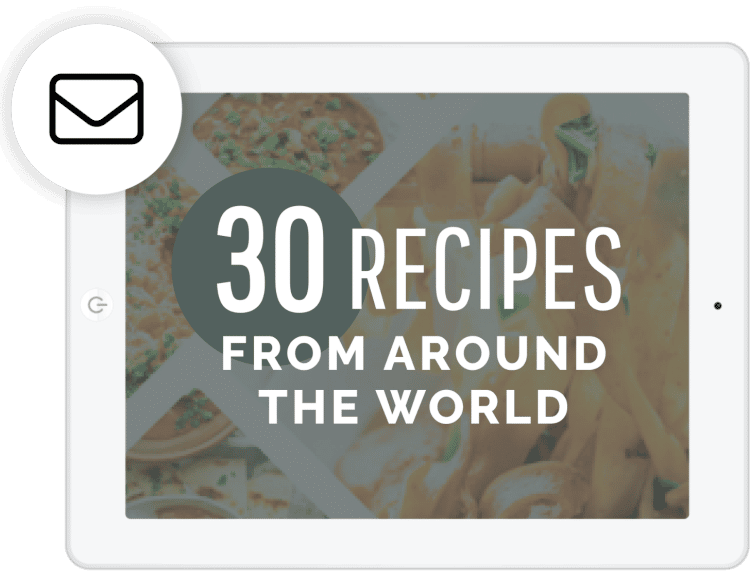Fast and Easy No Knead Bread
This post may contain affiliate links. Please read my disclosure policy.
Discover the simplicity of my Fast and Easy No Knead Bread recipe, ideal for both novices and time-conscious bakers! Delight in crafting delicious homemade bread while relishing the enticing scent as it bakes to golden perfection in your very own kitchen.
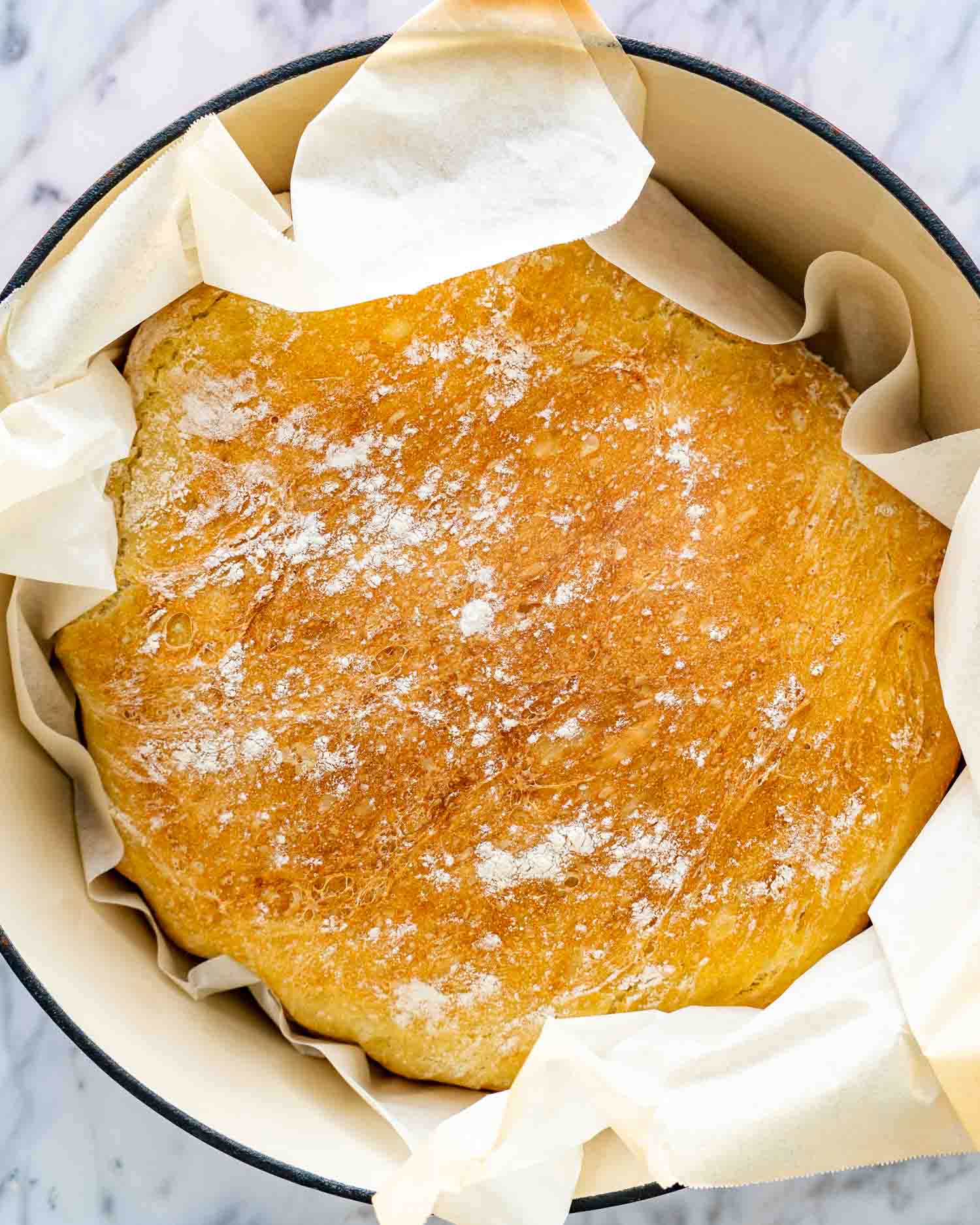
Fast And Easy No Knead Bread Recipe
I’m excited to share a fantastic no-knead bread recipe that’s both easy, fast and delicious. This foolproof bread making method will have you enjoying a beautiful loaf of homemade bread without any complicated steps or techniques.
The original No Knead Bread uses active dry yeast and takes about 12 to 18 hours for the dough to rise, while this dough takes a lot less time because I’m using instant yeast. This no knead bread can be on your dinner table in about 2½ hours which is an impressive improvement over the original.
What Is No Knead Bread?
No Knead Bread was first published in the New York Times about 10 years ago. It’s a bread you make that, obviously, requires no kneading which is why it’s become so popular. You basically throw everything in a bowl, mix it up, let it sit around for a few hours and let the yeast do its work, then bake it.
The slow rise is what gives the bread that great flavor, and the baking method is what gives it that incredible crispy crust. This version, is a little bit different. Here we’re using instant yeast which saves us from waiting 12 to 18 hours for the dough to slowly rise.
Not only do I use instant yeast, but I use a lot more of it. I also do 2 rises, first rise for one hour, second rise for 30 minutes. The other change made to this recipe is that I doubled the recipe. Many of you have asked me if you can double the recipe and bake it in a bigger Dutch Oven. So I wanted to show you here that yes, it’s possible.

- Water: Lukewarm water activates the yeast and helps create a soft crumb in the bread. You can use tap water, but make sure it’s not too hot or too cold.
- Instant yeast: A key ingredient in this recipe, instant yeast is fast-acting and helps the bread rise without kneading. Active dry yeast can be used as a substitute, but it may require longer rising times.
- All-purpose flour: This flour is versatile and readily available, making it a great choice for no-knead bread. You can substitute some or all of the all-purpose flour with bread flour, which has a higher protein content and creates a chewier texture.
- Salt: Adds flavor to the bread and helps control the yeast’s growth. Kosher salt or sea salt can be used as a substitute, but reduce the amount by about 25% since they are coarser than table salt.
First, let’s gather our ingredients. You’ll need water, instant yeast, all-purpose flour, and salt. That’s it! If you want to add some mix-ins like nuts or seeds, feel free to do so.
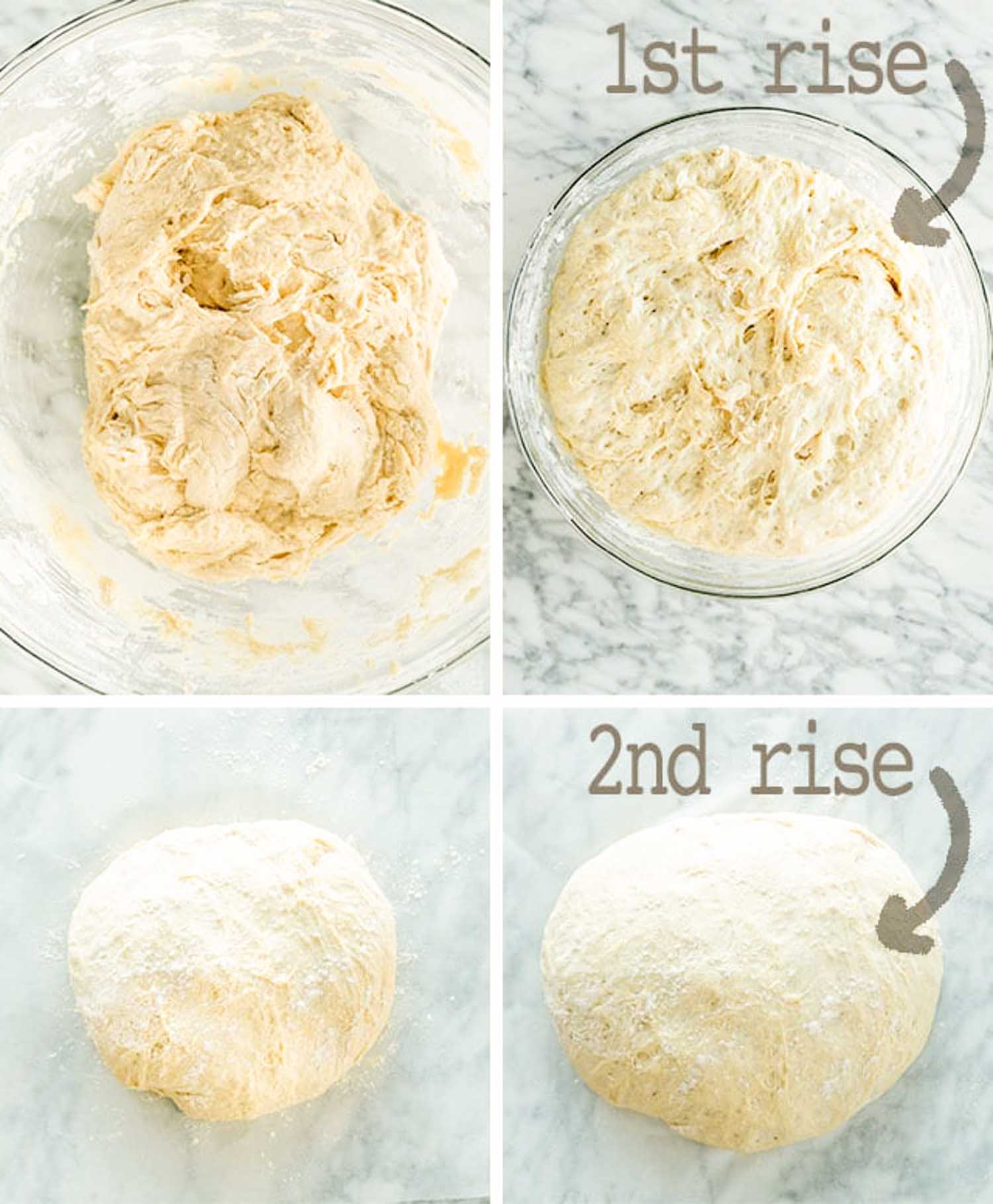
In a large mixing bowl, whisk together the water and yeast until combined. In a separate bowl, mix the flour and salt. Pour the flour mixture into the yeast mixture and stir with a wooden spoon until a sticky dough forms. It’s important not to overmix the dough, so just stir until everything is combined.
Cover the bowl with a dry kitchen towel and let the dough rise for about an hour, or until it has doubled in size.
Once the dough has risen, use a spatula to loosen it from the sides of the bowl. Flour your hands and sprinkle a bit of flour over the dough to prevent sticking. Gently remove the dough from the bowl and shape it into a ball. Place the dough onto a sheet of parchment paper and let it rise for another 30 minutes.
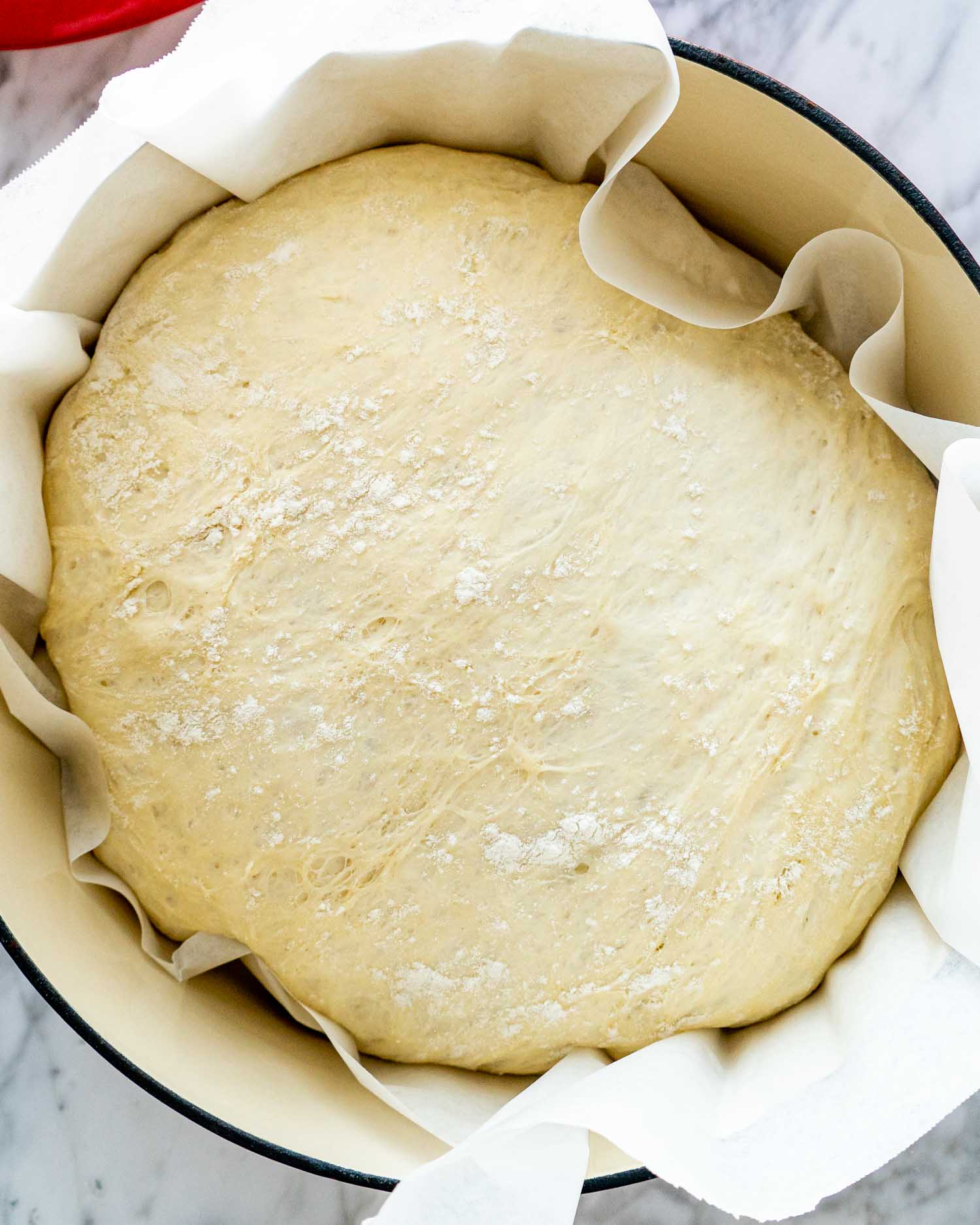
While the dough is rising, preheat your oven to 450°F and place a Dutch oven with its lid on inside to heat up during the preheat. Once the dough has finished its second rise, carefully remove the Dutch oven from the oven and take off the lid. Pick up the parchment paper and place the dough inside the pot. Put the lid back on and bake for 35 minutes with the lid on, and an additional 20-25 minutes with the lid off, or until the bread is golden brown.
Take the bread out of the pot and let it cool completely on a wire rack before slicing. Once cooled, slice it up and serve with butter or your favorite toppings. Enjoy!
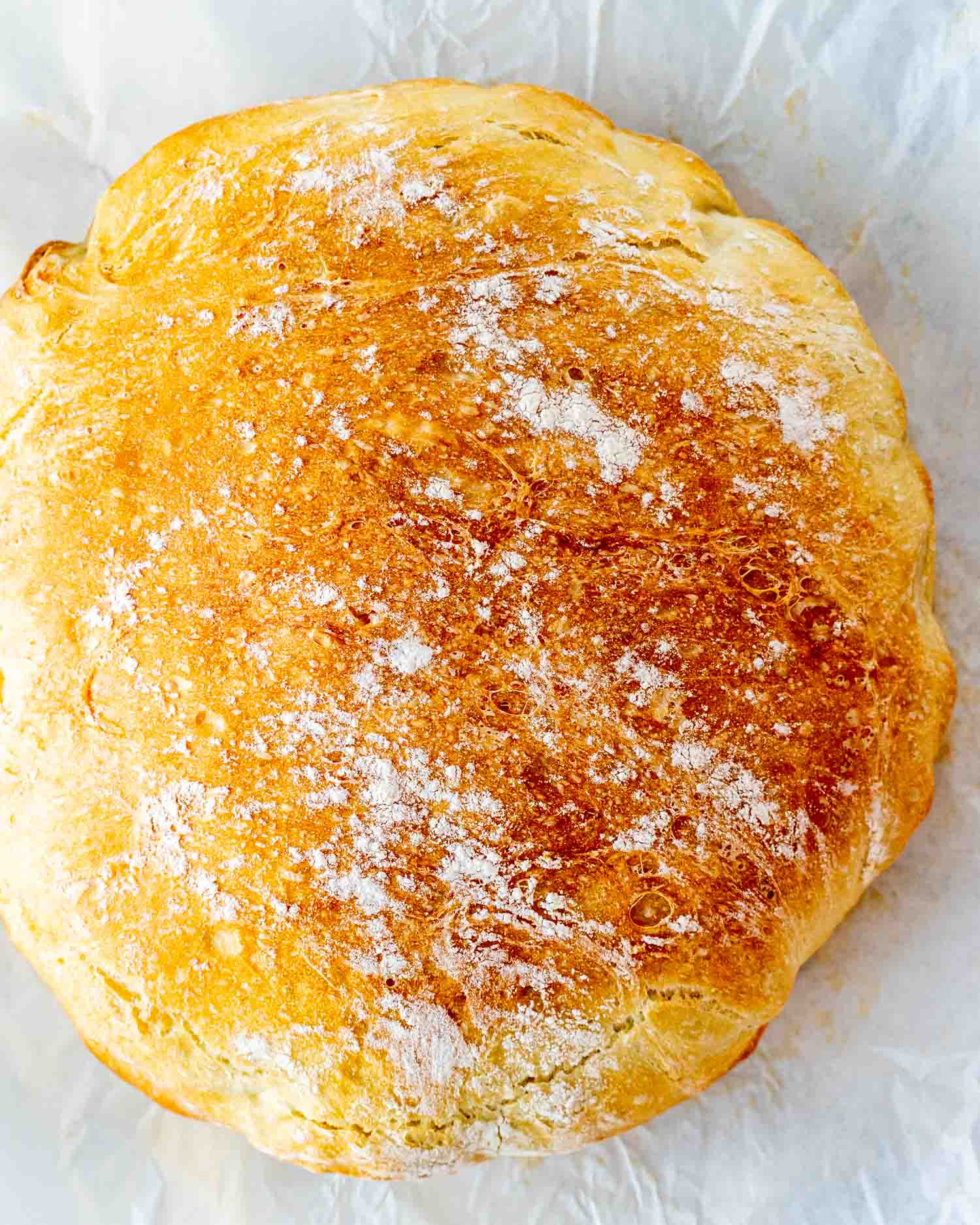
Frequently Asked Questions
Why is my dough sticky?
The dough for no-knead bread should be sticky and wetter than traditional bread dough. This high hydration helps create a soft and airy crumb inside the bread. When handling the sticky dough, make sure to flour your hands and work surface to prevent it from sticking too much. Avoid adding too much extra flour to the dough, as it can make the bread denser and tougher.
Can I use active dry yeast instead of instant yeast?
Yes, you can use active dry yeast. Just be sure to dissolve it in the lukewarm water before mixing with the flour. You may also need to increase the rising time slightly.
Can I add mix-ins like seeds, nuts, or dried fruit?
Absolutely! Feel free to customize your no-knead bread by adding your favorite mix-ins like sunflower seeds, chopped nuts, dried fruits, or herbs. Add them during the initial mixing process to distribute them evenly throughout the dough.
What if I don’t have a Dutch oven?
You can use a heavy lidded oven-safe pot or casserole dish as an alternative. Just make sure it can withstand high temperatures (450°F / 232°C). Alternatively, you can use a baking stone or an overturned oven-safe bowl or pot to cover the bread and trap steam.
My bread turned out dense and heavy. What went wrong?
There could be several reasons for this, including using expired yeast, not allowing the dough to rise sufficiently, or using too much flour. Be sure to check the freshness of your yeast, give the dough enough time to rise, and measure your flour accurately to avoid this issue.
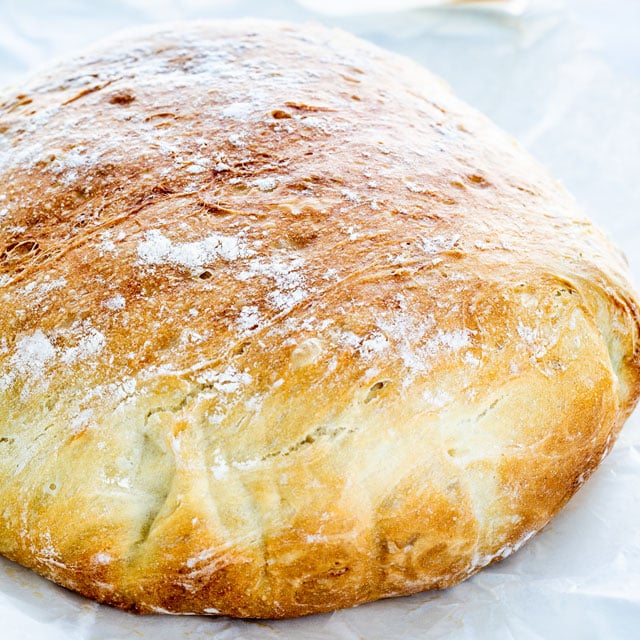
Expert Tips
- Temperature control: Ensure your water is lukewarm, not too hot or too cold. The ideal temperature is around 105°F to 110°F (40°C to 43°C) to activate the yeast without killing it.
- Yeast freshness: Check the expiration date of your instant yeast before using it. Expired yeast may not activate properly, resulting in poor dough rise.
- Flour choice: While all-purpose flour works well in this recipe, you can also experiment with bread flour for a slightly chewier texture.
- Rising environment: Find a warm, draft-free spot for your dough to rise. Ideal rising temperatures are around 75°F to 80°F (24°C to 27°C).
- Preheating the Dutch oven: Preheating your Dutch oven properly is crucial for a crispy crust. Be sure to give it enough time to heat up thoroughly before adding the dough.
- Parchment paper: Use parchment paper not only to transfer the dough into the hot Dutch oven easily but also to prevent sticking and make clean-up easier.
- Steam for a crispy crust: Baking the bread with the Dutch oven’s lid on for the first part of the baking process helps create steam, which contributes to a crispy, golden crust.
- Internal temperature: Use an instant-read thermometer to check the internal temperature of your bread. The bread is done when it reaches an internal temperature of about 190°F to 200°F (88°C to 93°C).
- Cooling: Allow the bread to cool completely on a wire rack before slicing. This helps the crust stay crispy and prevents the bread from becoming gummy.
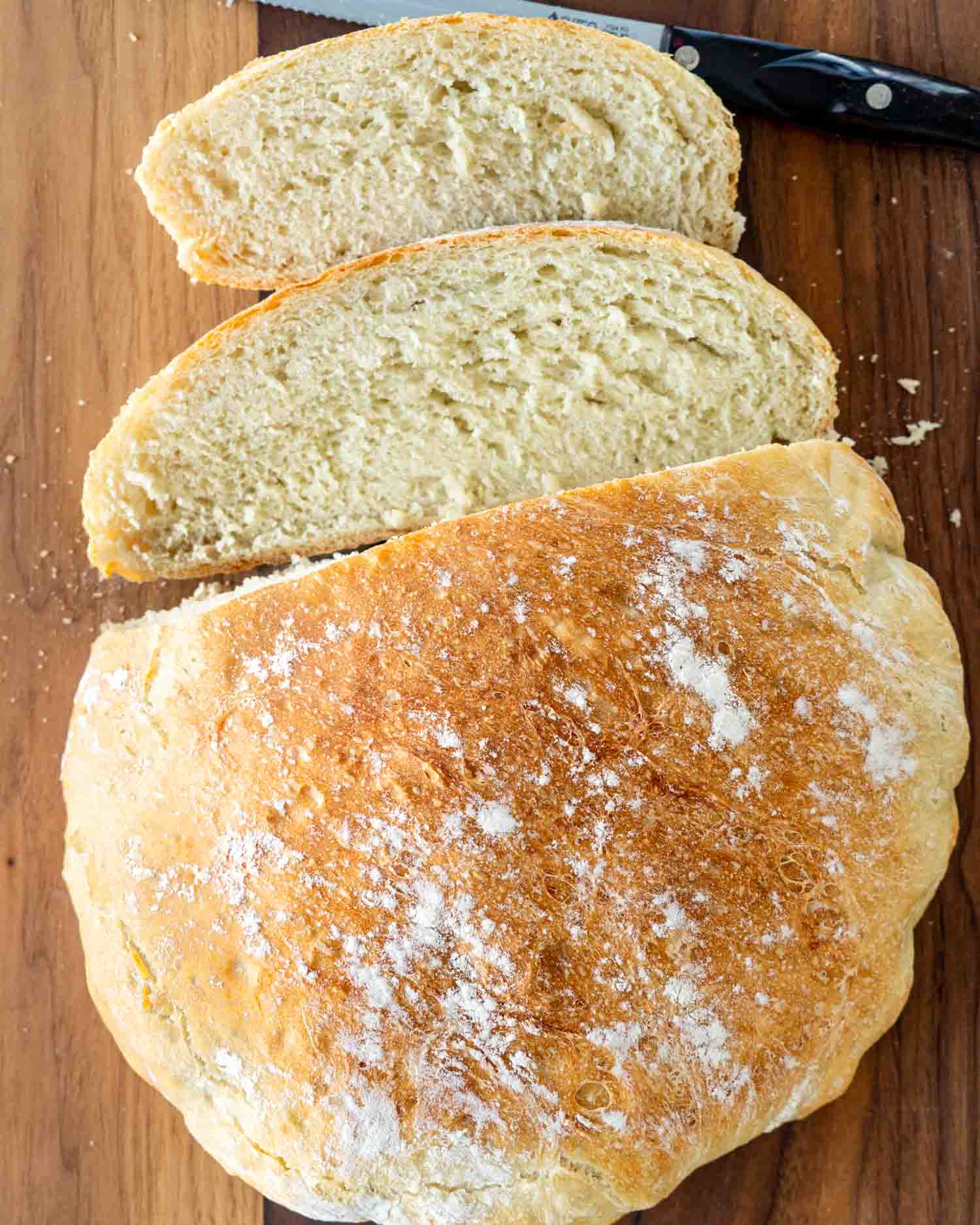
Storage
To store no-knead bread and keep it fresh, first allow the bread to cool completely on a wire rack. Cooling prevents the crust from becoming soggy and the interior from getting gummy. Once cooled, wrap the bread loosely in a clean kitchen towel or place it in a paper bag. This helps maintain the bread’s crispy crust while keeping the inside soft.
Avoid using plastic bags or airtight containers, as they can trap moisture and cause the bread to become soggy. Store the bread at room temperature, away from direct sunlight and heat sources. If you have a bread box, it’s an ideal place for storage.
No-knead bread is best enjoyed within 2-3 days. To extend its freshness, you can freeze the bread by wrapping it tightly in plastic wrap or aluminum foil and placing it in a freezer-safe bag. It can be stored in the freezer for up to 3 months. To thaw, leave it at room temperature for a few hours or reheat it in the oven at a low temperature until warmed through.
Do You Love This Bread Recipe? Try These!
- Dutch Oven No Knead Bread
- No Knead Skillet Bread
- Whole Wheat No Knead Bread
- No Knead One Hour Cinnamon Rolls
- No Knead Hot Cross Buns
- Muffuletta Bread
- No Knead Honey Oat Bread
- Ciabatta
- No-Knead Baguette
- No Knead Cinnamon Raisin Bread
- No Knead Potato Bread
Before You Begin! If you make this, please leave a review and rating letting us know how you liked this recipe! This helps our business thrive & continue providing free recipes.
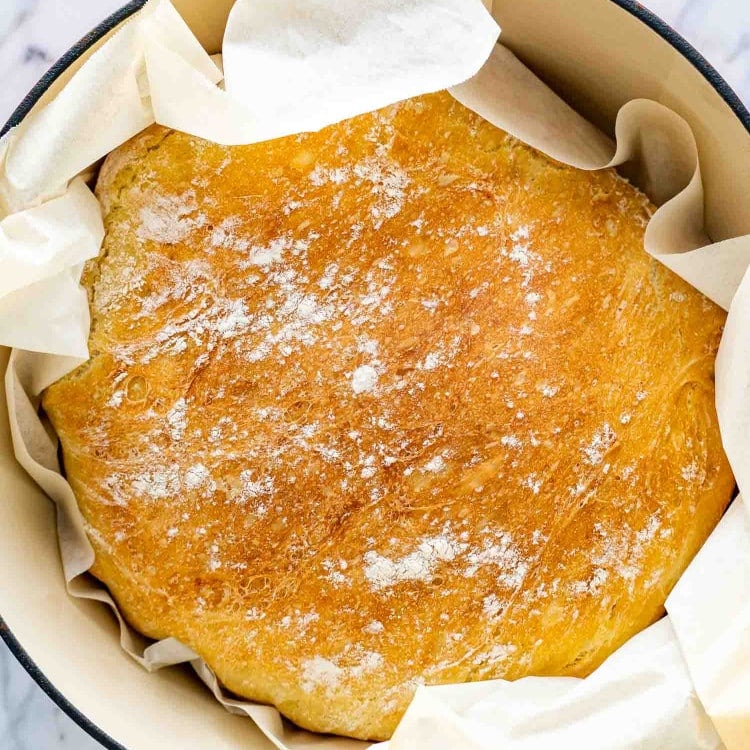
Fast and Easy No Knead Bread
Video
Ingredients
- 3 cups water (lukewarm)
- 4½ teaspoon instant yeast ((2 packets))
- 6 cups all-purpose flour
- 1 tablespoon salt
Before You Begin! If you make this, please leave a review and rating letting us know how you liked this recipe! This helps our business thrive & continue providing free recipes.
Instructions
- In a large mixing bowl, whisk together the water and the yeast. In a separate bowl, mix the flour and salt well. Dump the flour mixture into the yeast mixture. Using a wooden spoon or spatula, mix the dough until it is well combined.
- Cover the bowl with a dry kitchen towel and set the dough aside to rise for 1 hour, or until doubled in size.
- After your dough has risen, use a spatula to loosen the dough from the edges of the bowl. Flour your hands really well and also sprinkle a bit of flour over the dough. With your floured hands gently remove the dough from the bowl and roughly shape it into a ball. Place the dough onto a large sheet of parchment paper and cover with a dry kitchen towel to rise for another 30 minutes.
- Preheat your oven to 450℉ and place your Dutch oven with its lid on inside to heat up during the preheat.
- Take the pot out of the oven, and remove the lid. Pick up the dough by grabbing all four corners of the parchment paper, and carefully place the dough inside the pot.
- Place the lid back onto the pot, and return it to the oven. Bake for 35 minutes with the lid on, and 20-25 minutes with the lid off, or until the bread is golden brown.
- Remove the bread from the pot and allow it to cool completely before slicing.
Notes
- I used a large 6 qt Dutch oven. A large Dutch oven is better here because this recipe is meant to make a big loaf. You can cut the recipe in half if you’d like to use a smaller Dutch oven.
- If the dough mixture is too dry, add a bit more water, the dough should be sticky and messy, as seen in the video.
- To add other ingredients to the bread such as dried fruit, seeds, herbs or cheeses, add them in step 1 when mixing everything together.
- How do I know when my bread is done baking: Tap the bottom! Take the bread out of the Dutch oven, turn it upside down and give the bottom a firm thump with your thumb, or a knock and if it sounds hollow it’s done. If using an instant thermometer, the internal temperature should be around 200 F degrees.
Nutrition Information
Notice: Nutrition is auto-calculated for your convenience. Where relevant, we recommend using your own nutrition calculations.

